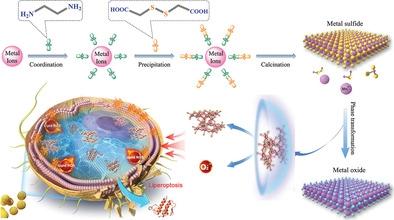当前位置:
X-MOL 学术
›
Adv. Funct. Mater.
›
论文详情
Our official English website, www.x-mol.net, welcomes your
feedback! (Note: you will need to create a separate account there.)
Coordination-Precipitation Synthesis of Metal Sulfide with Phase Transformation Enhanced Reactivity against Antibiotic-Resistant Bacteria
Advanced Functional Materials ( IF 18.5 ) Pub Date : 2023-02-02 , DOI: 10.1002/adfm.202212655 Yuan Liu 1 , Xiaonan Wang 2 , Xiaowan Fan 1 , Mengyue Ge 1 , Ling Fang 2 , Ye Yuan 1 , Lei Chen 2 , Jing Jiang 2 , Anmin Cao 3 , Lizeng Gao 1, 2
Advanced Functional Materials ( IF 18.5 ) Pub Date : 2023-02-02 , DOI: 10.1002/adfm.202212655 Yuan Liu 1 , Xiaonan Wang 2 , Xiaowan Fan 1 , Mengyue Ge 1 , Ling Fang 2 , Ye Yuan 1 , Lei Chen 2 , Jing Jiang 2 , Anmin Cao 3 , Lizeng Gao 1, 2
Affiliation

|
Given the challenge of bacterial resistance to antibiotics, there is an urgent need to develop alternative antibacterial agents. While some metal sulfides are promising candidates against bacterial resistance, their fundamental mechanism of action (MoA) remains unclear. Herein, a “coordination-precipitation” method is developed for the synthesis of a metal sulfide library and the evaluation of antibacterial consistency. Employing ethylenediamine as a coordination agent and thioglycolic acid as a precipitation agent, 12 different metal sulfide nanocrystals following the same procedure are synthesized. Antibacterial assessment reveals that six metal sulfides with bactericidal potency perform a common feature of phase transformation. In particular, in the process of manganese sulfide (MnS) transformation to Mn3O4, a highly reactive complex of high-valance manganese (Mn3+) and polysulfide (S32−) accompanied by superoxide is sustainably generated, which synergistically induces bacterial death with a hallmark of lipid peroxidation (named liperoptosis) specifically toward Gram-positive Staphylococcus aureus (S. aureus). In addition, this MoA confers MnS with therapeutic effects superior to vancomycin in a methicillin-resistant S. aureus-infected skin wound model. This study reveals the correlation between phase transformation and the antibacterial MoA of metal sulfides and provides a general fundamental to design a non-antibiotic antibacterial candidate against bacterial resistance.
中文翻译:

金属硫化物的配位沉淀合成与相变增强对抗生素耐药细菌的反应
鉴于细菌对抗生素耐药性的挑战,迫切需要开发替代抗菌剂。虽然一些金属硫化物是有前途的抗细菌耐药性候选物,但它们的基本作用机制 (MoA) 仍不清楚。在此,开发了一种“配位-沉淀”方法用于金属硫化物库的合成和抗菌一致性的评价。采用乙二胺作为配位剂,巯基乙酸作为沉淀剂,按照相同的步骤合成了 12 种不同的金属硫化物纳米晶体。抗菌评估表明,六种具有杀菌效力的金属硫化物具有相变的共同特征。特别是在硫化锰(MnS)转化为Mn 3 O的过程中如图 4 所示,持续生成高价锰 (Mn 3+ ) 和多硫化物 (S 3 2− ) 以及超氧化物的高反应性复合物,协同诱导细菌死亡,其特征是脂质过氧化(称为脂肪凋亡),特别是针对革兰氏-阳性金黄色葡萄球菌(S. aureus)。此外,该 MoA 赋予 MnS 在耐甲氧西林金黄色葡萄球菌感染的皮肤伤口模型中优于万古霉素的治疗效果。这项研究揭示了相变与金属硫化物的抗菌 MoA 之间的相关性,并为设计针对细菌耐药性的非抗生素抗菌候选药物提供了一般基础。
更新日期:2023-02-02
中文翻译:

金属硫化物的配位沉淀合成与相变增强对抗生素耐药细菌的反应
鉴于细菌对抗生素耐药性的挑战,迫切需要开发替代抗菌剂。虽然一些金属硫化物是有前途的抗细菌耐药性候选物,但它们的基本作用机制 (MoA) 仍不清楚。在此,开发了一种“配位-沉淀”方法用于金属硫化物库的合成和抗菌一致性的评价。采用乙二胺作为配位剂,巯基乙酸作为沉淀剂,按照相同的步骤合成了 12 种不同的金属硫化物纳米晶体。抗菌评估表明,六种具有杀菌效力的金属硫化物具有相变的共同特征。特别是在硫化锰(MnS)转化为Mn 3 O的过程中如图 4 所示,持续生成高价锰 (Mn 3+ ) 和多硫化物 (S 3 2− ) 以及超氧化物的高反应性复合物,协同诱导细菌死亡,其特征是脂质过氧化(称为脂肪凋亡),特别是针对革兰氏-阳性金黄色葡萄球菌(S. aureus)。此外,该 MoA 赋予 MnS 在耐甲氧西林金黄色葡萄球菌感染的皮肤伤口模型中优于万古霉素的治疗效果。这项研究揭示了相变与金属硫化物的抗菌 MoA 之间的相关性,并为设计针对细菌耐药性的非抗生素抗菌候选药物提供了一般基础。































 京公网安备 11010802027423号
京公网安备 11010802027423号